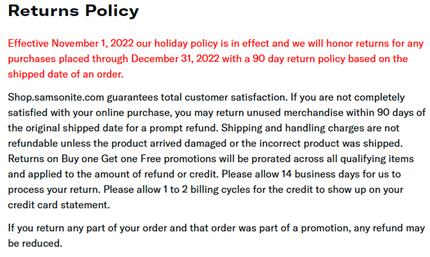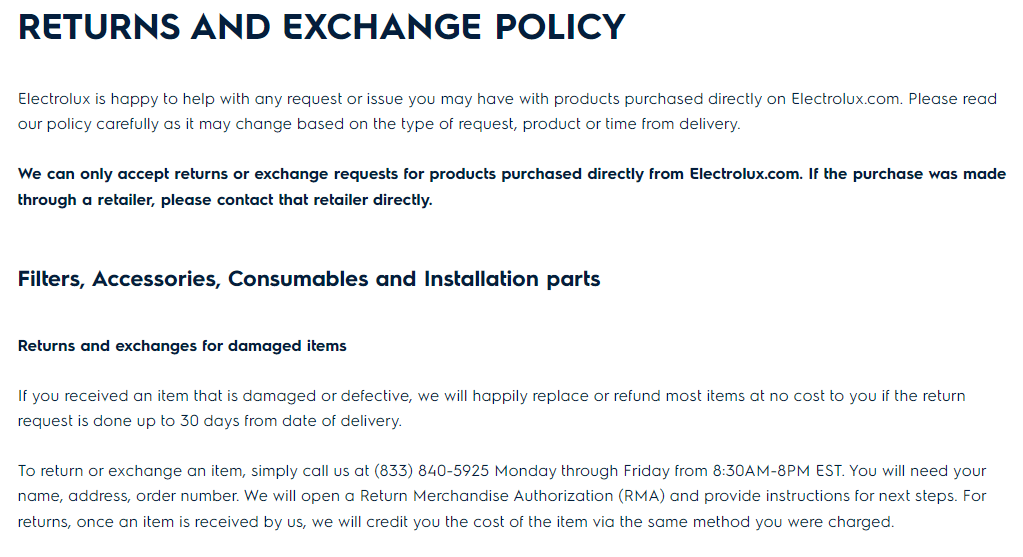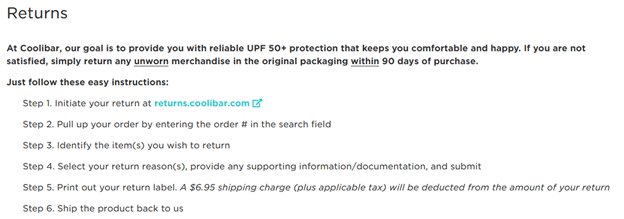Writing a Return Policy: What to Include, Best Practices & More

Returns, refunds and exchanges are an important part of operations for most B2C and B2B businesses. Here at ReverseLogix, we work with large companies and global brands to make their returns processes efficient, fast and cost-effective.
Any return process should begin with a clear, concise, and fair return policy for buyers. In fact, two-thirds of buyers check a company’s return policy before purchasing.
In this article, you’ll learn how to write a smart policy that is easy for your customers and reasonable for you.
What is a Returns and Refund Policy?
A return policy is the stated rule that explains how a customer can return unwanted merchandise after they have purchased it. A return policy may also include details for exchanges, credits or refunds.
Why is a Return Policy Important?
A return policy is essential for both B2C and B2B retail; it instills trust with your company and increases the likelihood that customers will shop with you again. A study in the Journal of Marketing found that an easy returns process increases customer purchases over the next two years by 58% – 357%.
A return policy is also important for your operations: It sets guidelines for when you will or won’t accept a return, and it helps employees understand the expectations and rules for processing returns and issuing exchanges, credits or refunds.
What to Include in a Return Policy
Most customers don’t expect every seller to offer a generous, Amazon-like return policy. However, they do expect to know that if they are unhappy with a purchase, they can make a product return quickly and easily.
Return Policy Best Practices
Here are a few broad best practices to incorporate into any return policy.
Make your policy easy to find on the website: This is especially important because, as noted above, most shoppers check return policies before purchasing. Whether you are in a B2C or B2B business (or both), make the policy easy to find so shoppers don’t get discouraged, lose trust, and leave your site.
Don’t copy and paste another company’s policy: Make sure the return policy addresses your specific needs, deadlines and realities. If a competitor can process a return faster than you, don’t over-promise just to compete; set realistic expectations so you’ll have happier customers.
Make it easy to read and understand: Avoid legalese that may confuse customers. Avoid phrases like “we are not responsible for” that put extra responsibility on your customers.
Include detailed information: Clearly indicate the conditions for getting a refund or credit, with reasonable timelines. If you use automated customer communications for returns, let customers know that ahead of time. That way, you can reduce call volumes to customer service teams.
Include contact information: Help customers easily reach out to you with questions. Make sure customer-facing employees are educated about the return policy and that they are empowered to make decisions according to customers’ specific situations.
Use returns technology: A returns management system (RMS) is a type of supply chain software purpose-built to help companies automate and orchestrate the entire returns lifecycle, from start to finish.
An RMS helps you track and streamline returns so you don’t end up losing more money or making customers mad when things get lost or refunds get delayed. An RMS platform can also help you get products restocked for resale, diverted to be sold for a discount, and recycled or disposed of properly so they’re not sitting in your warehouse taking up space.

An RMS can support the details of your return policy, so you can do right by your customers and the company. Ultimately, it can help you lower your overall return volumes, which is especially important for reducing eCommerce returns.
- A customer portal for easy, self-service return initiation
- Help you set up policies to incentivize exchanges over refunds, retain revenue, and keep customers coming back
- Speed up returns by automatically approving, rejecting, or flagging returns and exchanges for review based on conditions you set
- Prioritize customer convenience with return options: Drop-off locations, box-less returns with QR code, sustainable options, etc.
- Set rules for approved buyers to receive an instant credit or refund
Tips for Writing a Return Policy
Here are a few recommendations for writing your return policy. Remember: it should be specific to your customer needs and your operational/resource realities.
If you have a returns policy today, it’s important to revisit the policy each year and ask:
- Have your operations changed?
- Have supply chain constraints altered what you can promise and when?
- Do you need to rethink fees or timelines?
- Should you consider a holiday season return policy that differs from your typical return policy?
These are all important questions to ask each year so you can be proactive with your policies and set appropriate expectations with customers.
Keep it Simple
Succinctly describe the process or list the steps for returning items. Include contact information such as an email address or phone number where people can reach out with questions. Clearly outline what products are eligible for a refund, what your exchange policy is, and what is a “final sale” item that cannot be returned. Spell out the condition that items must be in for returns: For example, new with the tags still on.
Make sure deadlines are clearly stated. Most online stores set a limit of 30, 60, or 90 days to return items. If you sell highly seasonal items, a shorter limit may be appropriate to allow you the best chance to resell an item. Also clearly specify if the window starts from the date of the purchase, date of shipment, or some other date.
Treat returns and exchanges as a sales opportunity
Returns can’t be entirely eliminated, but you can approach the returns process as an opportunity to engage with customers. For example, use it to gather feedback on an item for future improvements.
You can further strengthen customer loyalty with a super-easy returns process that puts the right product in their hands, or gets them a refund or credit quickly. In other words, a return isn’t always a negative occurrence if you can reinforce an experience of client-centered service and ease.
Collect (and use) product return data
Returns shouldn’t occur in a vacuum: Track and analyze which products are coming back, from which customers, at which times, and why. Returns data that rolls up by item category or type can help you proactively identify product issues or offer tools that better help customers choose the right item the first time.
Here’s an example of how our customer, Samsonite, and their third-party repair centers use ReverseLogix returns data to improve the customer experience.
“ReverseLogix allows us and Samsonite to track what parts may need more attention than others, what parts are used more, what parts may be more defective than other parts. It allows us to prepare for what’s coming next.”
What should I Avoid in my Return Policy?
A return policy should be written according to your business needs and customer needs. But in general, a return policy should not be vague, should not change often, and should not be completely inflexible in the event of a customer’s unique situation.
Should I Offer Store Credit in my Return Policy?
Store credit in your return policy depends on your products, customer expectations and business needs. However, some retailers are using store credit and cash refunds to incentivize one action over another.
For instance, a national clothing retailer will issue a full refund of a returned item in the form store credit. But, if a customer wants the returned item’s cost to be refunded to their credit card, the retailer will deduct a shipping fee for the return. This incentivizes the customer to choose a store credit.
Who Pays the Shipping Costs to Return a Product?
With increased costs and higher return volumes, many companies are rethinking their “free returns” policy. About 49% of retailers offer free return shipping, according to Invespcro.
Should I Offer Free Returns?
Although about half of retailers charge for returns, customers want and expect free returns. In a report by PowerReviews, +75% of consumers said free returns were one of the most important considerations when shopping online. Whether your company offers free returns depends on your products, costs and typical customer behavior. Learn more about the advantages and disadvantages of a free returns policy.
Where do I put a Return Policy on my Website?
Putting a link to “Returns” in your website footer is a common and easy-to-find location for most shoppers. From there, the link should take the visitor to your returns policy page that clearly states the rules, timelines and expectations for returns and exchange policies. The “Returns” page should also be the place where consumers can begin a return with a customer returns portal.
How do you Handle Customer Returns?
Purpose-built returns management systems are a new category of supply chain software. Before RMS were on the market, companies had to piece together returns processes using a warehouse management system (WMS) or point systems.
But with the rise in online purchases coupled with huge volumes of product returns, RMS technology is a must.
Return Policy Examples
Here are a variety of return policy examples from ReverseLogix customers. Note that they are straightforward, brief and detailed.




